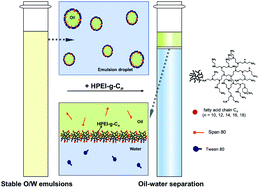Amphiphilic hyperbranched polyethyleneimine for highly efficient oil–water separation†
Abstract
To deal with the demulsification of O/W emulsions, a novel kind of core–shell structural amphiphilic soft matter, HPEI-g-Cn (n = 10, 12, 14, 16, 18), with hyperbranched polyethyleneimine (HPEI) as the core and fatty acid chain Cn as the shell, is designed and synthesized. With the existence of amphiphilic HPEI-g-Cn, O/W emulsions can be thoroughly separated into two phases with a clear oil–water interface to reach demulsification equilibrium within 40 min. The oil removal ratio can exceed 99.9% under the addition of 40 ppm in simulative emulsions, and simultaneously the water content in the oil phase is less than 0.01%. This demulsifier can also contribute to excellent separation efficiency (up to 99.9%) for O/W emulsions from two China's oilfields, and even for heavy oil emulsions. More importantly, it is noted that the HPEI-g-Cn demulsifiers after demulsification are evenly and tightly dispersed at the oil–water interface as shown by wide-angle X-ray scattering (WAXS) and cryo-electron microscopy (cryo-EM), which is beneficial to the subsequent recovery and utilization. With eco-friendly characteristics, outstanding demulsification performance and promising recyclability, the amphiphilic macromolecules HPEI-g-Cn as special soft matter display great promise to achieve industrial applications in the future.

- This article is part of the themed collection: Journal of Materials Chemistry A HOT Papers


 Please wait while we load your content...
Please wait while we load your content...